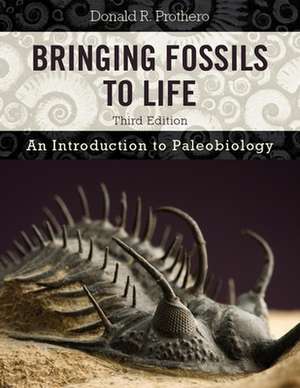Bringing Fossils to Life – An Introduction to Paleobiology 3e
Autor Donald Protheroen Limba Engleză Paperback – 28 noi 2013
| Toate formatele și edițiile | Preț | Express |
|---|---|---|
| Paperback (1) | 680.91 lei 43-57 zile | |
| Columbia University Press – 28 noi 2013 | 680.91 lei 43-57 zile | |
| Hardback (1) | 1138.75 lei 43-57 zile | |
| Columbia University Press – 5 dec 2013 | 1138.75 lei 43-57 zile |
Preț: 680.91 lei
Preț vechi: 884.30 lei
-23% Nou
Puncte Express: 1021
Preț estimativ în valută:
130.29€ • 136.40$ • 107.81£
130.29€ • 136.40$ • 107.81£
Carte tipărită la comandă
Livrare economică 07-21 aprilie
Preluare comenzi: 021 569.72.76
Specificații
ISBN-13: 9780231158930
ISBN-10: 0231158939
Pagini: 672
Ilustrații: 543 illustrations
Dimensiuni: 210 x 289 x 37 mm
Greutate: 1.59 kg
Ediția:3rd Edition.
Editura: Columbia University Press
ISBN-10: 0231158939
Pagini: 672
Ilustrații: 543 illustrations
Dimensiuni: 210 x 289 x 37 mm
Greutate: 1.59 kg
Ediția:3rd Edition.
Editura: Columbia University Press
Notă biografică
Donald R. Prothero
Cuprins
PrefaceTo the Student: Why Study Fossils?PART I: THE FOSSIL RECORD: A WINDOW ON THE PAST
1. The Fossil Record
What is a Fossil? How Does an Organism Become a Fossil? What Factors Affect the Fossilization Potential of an Organism? What Factors are Required for Extraordinary Preservation? How Good is the Fossil Record? Conclusions2. Variation in Fossils
Theme: Variation; How do Organisms vary during their Lifespans? How do Populations of Organisms Vary? Conclusions3. Species and Speciation4. Systematics
Why Systematics? Evolution and Classification; Competing Systematic Philosophies; Molecular Systematics; Codes of Systematic Nomenclature; Conclusions5. Evolution
The Evolution of Evolution; The "Evolutionary Synthesis"; Challenges to the Neo-Darwinian Synthesis; Evolution and the Fossil Record; Conclusions6. Extinction7. Functional Morphology
Form and Function; Theoretical Morphology; Functional Hypotheses as Testable Science; Case Studies in Functional Morphology; Conclusions8. Paleoecology
Ecology and Paleoecology; Ecological Relationships; Environmental Limiting Factors; Direct Paleoecological Evidence; Some Ecological Ideas that have been Applied (and Misapplied) to the Fossil Record; Evolutionary Paleoecology; Conclusions9. Biogeography
Organisms in Space and Time; Ecological Biogeography; Historical Biogeography; Conclusions10. Biostratigraphy
Faunal Succession; Biostratigraphic Zonations; Factors controlling Fossil Distributions; Biostratigraphic Sampling; The Time Significance of Biostratigraphic Events; North American Land Mammal "Ages" and Biochronology; Resolution, Precision, and Accuracy; Index Fossils and the Global Biostratigraphic Standard; ConclusionsPART II: LIFE OF THE PAST AND PRESENT
11. Life's Origins and Early Evolution
Concocting the "Primordial Soup"; Mud and Mosh Pits, Kitty Litter and Fool's Gold; Life is a Commune; The Earliest Fossils; Cambrian "Explosion"—or "Short Fuse"?; Why did Life Change So Slowly Before the Cambrian?; Rocks, Hox, and Molecular Clocks.12. Micropaleontology: Fossil Protistans
Introduction; The Kingdoms of Life; Systematics; Foraminifera; Radiolaria; Diatoms; Coccolithophores13. Colonial Life: Sponges, Archaeocyathans, and Cnidarians14. The Lophophorates: Brachiopods and Bryozoans15. Jointed Limbs: The Arthropods16. Kingdom of the Seashell: The Molluscs
Introduction; Systematics; Mollusc Origins and Diversification; Gastropods; Bivalves; Cephalopods17. Spiny Skins: The Echinoderms18. Dry Bones: Vertebrates and their Relatives
Introduction; The Road to Amphioxus; Getting a Head: The Craniates; Jaws: The Gnathostomes; Fish Bones The Osteichthyans; Lobe Fins: The Sarcopterygians; Four on the Floor: The Tetrapods; Land Eggs: The Amniotes; Feathered Dinosaurs: The Birds; Furry Folk: Synapsids and Mammals19. Fossilized Behavior: Trace Fossils20. Traces of Earth's Green Mantle: Paleobotany
Introduction; Plant Taphonomy; The First Photosynthetic Organisms; The Plant Kingdom; Vascular Plants; Tracheophytes; Naked Seeds: The Gymnosperms; Flower Power: The Angiosperm Revolution; Floras through Time GlossaryBibliographyIndex
1. The Fossil Record
What is a Fossil? How Does an Organism Become a Fossil? What Factors Affect the Fossilization Potential of an Organism? What Factors are Required for Extraordinary Preservation? How Good is the Fossil Record? Conclusions2. Variation in Fossils
Theme: Variation; How do Organisms vary during their Lifespans? How do Populations of Organisms Vary? Conclusions3. Species and Speciation4. Systematics
Why Systematics? Evolution and Classification; Competing Systematic Philosophies; Molecular Systematics; Codes of Systematic Nomenclature; Conclusions5. Evolution
The Evolution of Evolution; The "Evolutionary Synthesis"; Challenges to the Neo-Darwinian Synthesis; Evolution and the Fossil Record; Conclusions6. Extinction7. Functional Morphology
Form and Function; Theoretical Morphology; Functional Hypotheses as Testable Science; Case Studies in Functional Morphology; Conclusions8. Paleoecology
Ecology and Paleoecology; Ecological Relationships; Environmental Limiting Factors; Direct Paleoecological Evidence; Some Ecological Ideas that have been Applied (and Misapplied) to the Fossil Record; Evolutionary Paleoecology; Conclusions9. Biogeography
Organisms in Space and Time; Ecological Biogeography; Historical Biogeography; Conclusions10. Biostratigraphy
Faunal Succession; Biostratigraphic Zonations; Factors controlling Fossil Distributions; Biostratigraphic Sampling; The Time Significance of Biostratigraphic Events; North American Land Mammal "Ages" and Biochronology; Resolution, Precision, and Accuracy; Index Fossils and the Global Biostratigraphic Standard; ConclusionsPART II: LIFE OF THE PAST AND PRESENT
11. Life's Origins and Early Evolution
Concocting the "Primordial Soup"; Mud and Mosh Pits, Kitty Litter and Fool's Gold; Life is a Commune; The Earliest Fossils; Cambrian "Explosion"—or "Short Fuse"?; Why did Life Change So Slowly Before the Cambrian?; Rocks, Hox, and Molecular Clocks.12. Micropaleontology: Fossil Protistans
Introduction; The Kingdoms of Life; Systematics; Foraminifera; Radiolaria; Diatoms; Coccolithophores13. Colonial Life: Sponges, Archaeocyathans, and Cnidarians14. The Lophophorates: Brachiopods and Bryozoans15. Jointed Limbs: The Arthropods16. Kingdom of the Seashell: The Molluscs
Introduction; Systematics; Mollusc Origins and Diversification; Gastropods; Bivalves; Cephalopods17. Spiny Skins: The Echinoderms18. Dry Bones: Vertebrates and their Relatives
Introduction; The Road to Amphioxus; Getting a Head: The Craniates; Jaws: The Gnathostomes; Fish Bones The Osteichthyans; Lobe Fins: The Sarcopterygians; Four on the Floor: The Tetrapods; Land Eggs: The Amniotes; Feathered Dinosaurs: The Birds; Furry Folk: Synapsids and Mammals19. Fossilized Behavior: Trace Fossils20. Traces of Earth's Green Mantle: Paleobotany
Introduction; Plant Taphonomy; The First Photosynthetic Organisms; The Plant Kingdom; Vascular Plants; Tracheophytes; Naked Seeds: The Gymnosperms; Flower Power: The Angiosperm Revolution; Floras through Time GlossaryBibliographyIndex
